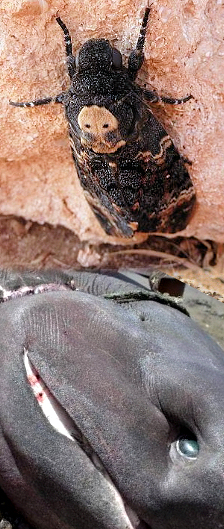A CAGARRA
Boletim de Sociedade Caboverdiana de Zoologia
Edited by | Editado por Cornelis J. Hazevoet cjhazevoet at gmail.com
No. 10 - JUNE / JUNHO DE 2015

Have you seen, heard or read something of zoological interest? Let us know!
Viu, leu ou ouviu algo com interesse zoológico recentemente? Informe-nos!
Local fishermen landed two bluntnose sixgill sharks Hexanchus griseus (Bonnaterre, 1788) at Quebra Canela beach, Praia, 31 March 2015. One of the sharks contained seven fully grown embryos and was apparently close to giving birth. The two animals were quickly butchered on the beach and the meat sold. No (part of a) specimen was preserved, but a number of snapshots and a video were made at the landing location. No measurements were taken, but the photos allowed for an estimate of 3 to 3.5 m for one of the animals. Although precise information on the distribution of sharks in Cape Verde waters is well-nigh non-existent and hard to come by, a landing of Hexanchus griseus does not appear to be a common event.
Bluntnose sixgill shark is widespread in temperate and tropical seas. In the eastern Atlantic it ranges from Norway to Senegal and has also been recorded from Angola and Namibia. Adult females (which average larger than males) can reach a total length of at least 4.82 m and probably 5.5 m. These heavy-bodied and broad-headed sharks are slow but strong swimmers and while adults are passive, even reported docile by divers, young are aggressive when captured. Habitat is described as shelves and slopes of continents, islands, seamounts and mid-ocean ridges, usually at depths of 500-1100 m, to at least 1875 m. Young may occur close inshore and adults in shallow water close to submarine canyons (Compagno et al. 2005). Dossa et al. (2011) listed Hexanchus griseus for the Cape Verde Islands without reference to the source of their information. It was not included by Wirtz et al. (2013), but it is unclear whether this was meant to indicate a genuine absence of records from Cape Verde waters or because it was judged to be not a coastal taxon. CJH.
References
-- Compagno, L., M. Dando & S. Fowler, 2005. Sharks of the world. Princeton University Press, Princeton & Oxford. 368 pp.
-- Dossa, S.J., M.S. Diop, L. Harrison & N. Dulvy, 2011. Statut et occurrence des espèces de raies et requins identifiées dans les débarquements dans les sept pays de la Commission Sous Régionale des Pêches (CSRP), Afrique de l’Ouest. Poster presented at the Coloque International sur les Requins, Dakar, Sénégal, 25-27 julliet 2011.
-- Wirtz, P., A. Brito, J.M. Falcón, R. Freitas, R. Fricke, V. Monteiro, F. Reiner & O. Tariche, 2013. The coastal fishes of the Cape Verde Islands – new records and an annotated check-list. Spixiana 36: 113-142.
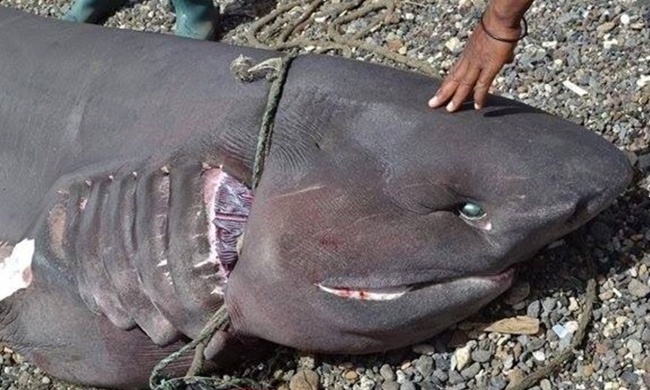
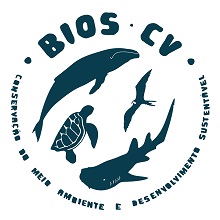 BIOS.CV conducted humpback whale Megaptera novaeangliae
monitoring activities off NW Boa Vista from 17 March to 20 May 2015.
Because of adverse weather conditions and/or lack of guests to
participate in the whale tours, we only sailed on 47 days, totalling 65
trips. Fieldwork effort was 172 hours of navigation during which we
travelled a distance of 1,437 km. A total of 48 humpback sightings were
reported, involving approximately 60-70 different individual humpback
whales. More than half of these have already been recognized by their
ventral fluke pattern and/or dorsal fin as frequent visitors to the
waters of Sal Rei Bay, while the rest are awaiting further
photo-identification analysis. Preliminary results indicate that at
least five different mother/calf pairs were sighted. Some resightings
once again confirmed the link between the Cape Verde breeding grounds
and northern latitude feeding areas in the central-eastern North
Atlantic. Six whales had previously been photographed off Norway, two
off Azores, one off both Norway and Azores and one off Iceland. This
has probably been the poorest whale season in the last five years in
terms of sightings and number of whales, mostly due to strong trade
winds and rough seas. Other research teams working in the eastern
Caribbean islands have reported similar ‘windy weather’ conditions with
few sightings and a low number of whales. We would like to thank Boa
Vista Tours, Cabokaitours, Giggling-gecko Adventures, Maximus Sailing
Catamaran and Seara Real Lda. for their help and support during the
whale season. Research and monitoring activities were conducted under
permit Nº7/2005 issued by the National Directorate for the Environment
(DGA) of Cape Verde.
BIOS.CV conducted humpback whale Megaptera novaeangliae
monitoring activities off NW Boa Vista from 17 March to 20 May 2015.
Because of adverse weather conditions and/or lack of guests to
participate in the whale tours, we only sailed on 47 days, totalling 65
trips. Fieldwork effort was 172 hours of navigation during which we
travelled a distance of 1,437 km. A total of 48 humpback sightings were
reported, involving approximately 60-70 different individual humpback
whales. More than half of these have already been recognized by their
ventral fluke pattern and/or dorsal fin as frequent visitors to the
waters of Sal Rei Bay, while the rest are awaiting further
photo-identification analysis. Preliminary results indicate that at
least five different mother/calf pairs were sighted. Some resightings
once again confirmed the link between the Cape Verde breeding grounds
and northern latitude feeding areas in the central-eastern North
Atlantic. Six whales had previously been photographed off Norway, two
off Azores, one off both Norway and Azores and one off Iceland. This
has probably been the poorest whale season in the last five years in
terms of sightings and number of whales, mostly due to strong trade
winds and rough seas. Other research teams working in the eastern
Caribbean islands have reported similar ‘windy weather’ conditions with
few sightings and a low number of whales. We would like to thank Boa
Vista Tours, Cabokaitours, Giggling-gecko Adventures, Maximus Sailing
Catamaran and Seara Real Lda. for their help and support during the
whale season. Research and monitoring activities were conducted under
permit Nº7/2005 issued by the National Directorate for the Environment
(DGA) of Cape Verde.New book: Biodiversity of Boa Vista
Séverine Roques, Elena Abella & Pedro López Suárez, 2014. Bio | Diversidad Diversité | Boa Vista. Published by BIOS.CV.
ISBN 978-84-617-1575-6.
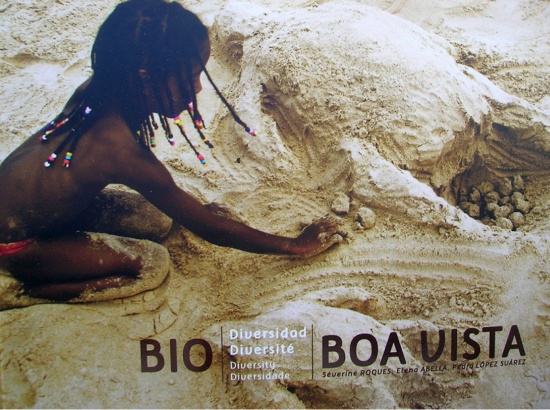
NOTÍCIAS ZOOLÓGICAS DE JORNAIS
“São tubarões tigre, uma espécie protegida a nível internacional, com uma reprodução muito lenta e por isso mesmo estão em grande declínio”, avança Tommy Melo, o Presidente da ONG nacional, Biosfera I. Melo pede o engajamento de biólogos a nível mundial para em conjunto condenar este acto criminoso em Cabo Verde. Há alguns meses atrás, o director-geral das Pescas, Juvino Vieira prometia um Plano de Conservação e Gestão do Tubarão. Em declarações à Inforpress, este responsável dizia em Agosto do ano passado que o objectivo desse plano será evitar o estado de “sobre-exploração” do tubarão em Cabo Verde. Segundo Juvino Vieira, no caso do tubarão, mesmo existindo espécies que possam ser pescados, é preciso ter em conta que existem outras que estão em vias de extinção e que por isso devem ser protegidas. A falta de fiscalização por parte das entidades competentes é vista como a principal causa deste problema.
Ocean Press, 7 de Abril 2015
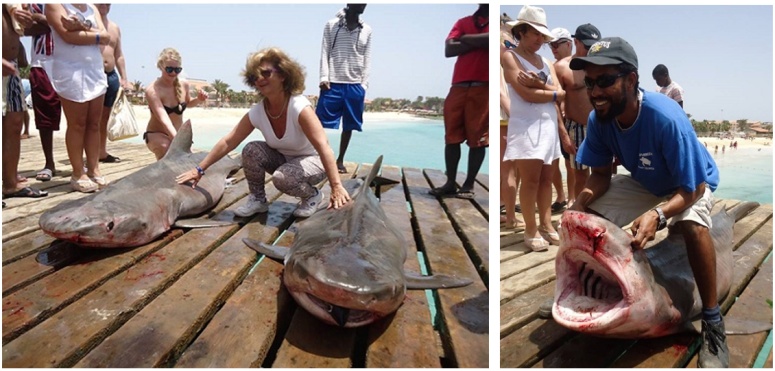
Santa Maria, Sal (© Eldon Monteiro).
As autoridades estão ainda a apurar os factos, no entanto, a nossa fonte explica que entre as causas prováveis que podem ter levado as baleias a desnortear-se podem estar a desorientação, doença entre outras. Euclides Gonçalves, responsável do ambiente da Câmara Municipal do Sal adiantou à nossa equipa no local que os mamíferos poderiam estar a seguir um líder pelo que o trabalho dos especialistas passou pela tentativa de o localizar para que este pudesse ser seguido pelo grupo de mais de duas dezenas de mamíferos, de volta para o mar aberto. Edélcio Gomes, membro da proteção civil da ilha do Sal lamenta que das 23 baleias-piloto que deram à costa, apenas sete sobreviveram. Estas foram devolvidas com sucesso. Quanto às que não foi possível salvar o procedimento agora é enterrá-las de forma a que não constituam perigo ambiental e também para evitar que algumas pessoas queiram consumir a sua carne. As Forças Armadas também colocaram vários militares no local que trabalharam incessantemente ao lado de civis e ambientalistas durante várias horas na operação de salvamento das baleias. Apesar de ser um fenómeno que ocorre com alguma frequência um pouco por todo o arquipélago nesta altura do ano, os especialistas afirmam que é a primeira vez que morrem tantos mamíferos nas praias da ilha do Sal.
Ocean Press, 1 de Maio 2015. See also TCV Jornal de Noite de 30 de Abril 2015.
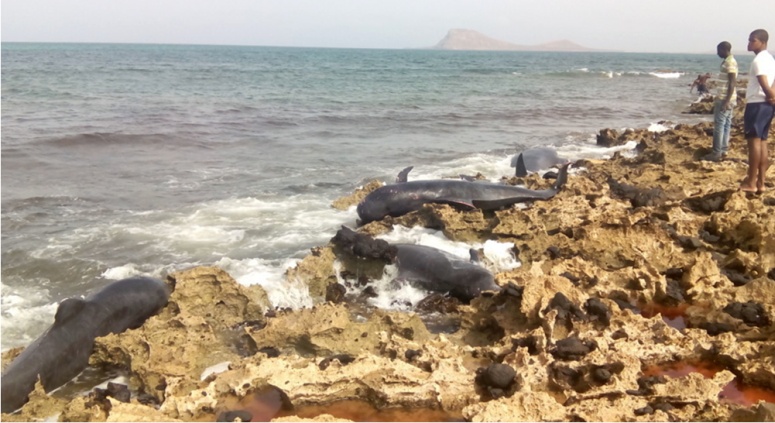
Capital de Cabo Verde sob vigilância apertada por causa da dengue
A Semana, 24 de Maio 2015
Publicações recentes sobre zoologia Caboverdiana
Community-based conservation: the key to protection of marine turtles on Maio Island, Cape Verde. Amanda Dutra & Franziska Koenen, 2014. Oryx 48 (3): 325;
http://dx.doi.org/10.1017/S0030605314000209
No abstract, but the complete (half a page) text can be read using the doi link above.
New and rare records of teleost fishes from the Cape Verde Islands (eastern-central Atlantic Ocean).
José A. González, Albertino Martins, José I. Santana, Raúl
Triay-Portella, Carlos Monteiro, Verónica García-Martín, Sebastián
Jiménez, Gustavo González-Lorenzo, José G. Pajuelo, José M. Lorenzo
& Manuel Biscoito, 2014. Cybium 38 (4): 289-300.
ABSTRACT
As a result of six exploratory surveys and several opportunistic
catches in the Cape Verde Islands from a few metres to about 1000 m of
depth, a list of 66 species of teleost fishes is given, six of which
are first records from the archipelago: Gnathophis mystax (Congridae), Nezumia africana, Nezumia duodecim (Macrouridae), Ectreposebastes imus (Scorpaenidae), Paraliparis sp. (Liparidae) and Lappanella fasciata (Labridae). Additionally, data on six poorly-known species is also given: Myroconger compressus (Myrocongridae), Myrichthys pardalis, Phaenomonas longissima (Ophichthidae), Sphagemacrurus hirundo (Macrouridae), Gadella imberbis and Physiculus cyanostrophus (Moridae). Data includes distribution, habitat, morphometry and reproduction.
Structure
and zonation of demersal and deepwater fish assemblages off the Cape
Verde archipelago (northeast-Atlantic) as sampled by baited longlines. Gui M. Menezes, Oksana Tariche, Mario R. Pinho, Michael F. Sigler & Helder M. Silva, 2015. Deep-Sea Research Part 1;
http://dx.doi.org/10.1016/j.dsr.2015.04.013
ABSTRACT
The assemblages of the demersal and deep-water fish assemblages of the
Cape Verde archipelago are described for the first time from a total of
20 longline hauls that extends from coastline to 1200 m water depth. A
total of 97 species from 49 different families were caught, and despite
the changes of biogeographic affinities with depth, the majority of the
species are from a Subtropical and Tropical origin or have a broad
geographic distribution (Wide and Amphi-Atlantic distributions) with
limited affinities with the Macaronesian islands and the Mediterranean.
Depth distribution profiles show a clear turnover of species with depth
and an increase in the depth distribution range of the deeper living
species. Furthermore, the indices of species abundance, biomass and the
number of species caught, significantly decreased with increasing
depth. Four main fish assemblages in a depth-aligned structure are
proposed in the present work. A shelf assemblage mainly distributed
above the 150 m depth strata, a shelf-break/upper-slope assemblage
mainly between the 150–350 m depth strata, a deep/upper-slope
assemblage between the 300-600 m depth strata, and a mid-deep/mid-slope
assemblage mainly distributed below the 600 m. Species abundances and
diversity found below 200 m is relatively low compared with shallow
waters. The observed depth zonation of the slope assemblages, roughly
agrees with the expected occurrence or influence of different water
masses: shelf and surface mixing and seasonal thermocline depth zone,
the depth range of occurrence of the intermediate waters (North
Atlantic Central Water - NACW), the South Atlantic Central Water -
SACW) and Atlantic Equatorial Water -AEW), a mixing or overlapping zone
of previous intermediate water masses with the Antarctic Intermediate
Water (AAIW) and the Mediterranean Outflow Water (MOW), and a deeper
zone where the AAIW predominate.
New species of mayflies (Ephemeroptera) from Cape Verde. Tomáš Soldáni & Jindřiška Bojková, 2015. Zootaxa 3926 (4): 561-575; http://dx.doi.org/10.11646/zootaxa.3926.4.6
ABSTRACT
To date, no mayflies have been described from Cape Verde, an
archipelago of volcanic islands in the Atlantic Ocean. Based on the
material collected on two islands, Santo Antão and Santiago, two
species of the genus Cloeon Leach, 1815 (Ephemeroptera: Baetidae) are described based on larvae and imagines. Cloeon morna sp. n., collected in Santo Antão, and C. sidadi
sp. n., collected in Santiago, have 3-segmented maxillary palps and
tapered labial palps of larvae. The new species can be distinguished
from each other and from other West-African species of the genus mainly
according to details of the lateral spines on larval abdominal segments
and characteristic colourations of vitta and terga in female imagines
and colours of male turbinate eyes. Affinities to the West African
species of the genus are discussed.
Larvicidal activity against Aedes aegypti of Foeniculum vulgare essential oils from Portugal and Cape Verde. D.K. Rocha, O. Matosc, M.T. Novoa, A.C. Figueiredo, M. Delgado & C. Monteiro, 2015. Natural Product Communications 10 (4): 677-682.
ABSTRACT
Dengue is a potentially fatal mosquito-borne infection with 50 million
cases per year and 2.5 billion people vulnerable to the disease. This
major public health problem has recurrent epidemics in Latin America
and occurred recently in Cape Verde and Madeira Island. The lack of
anti-viral treatment or vaccine makes the control of mosquito vectors a
high option to prevent virus transmission. Essential oil (EO)
constituents can affect insect's behaviour, being potentially effective
in pest control. The present study evaluated the potential use of Foenicultm vulgare (fennel) EO in the control of the dengue vector Aedes aegypti.
EOs isolated from fennel aerial parts collected in Cape Verde and from
a commercial fennel EO of Portugal were analysed by NMR, GC and GC-MS.
trans-Anethole (32 and 30%, respectively), limonene (28 and 18%,
respectively) and fenchone (10% in both cases) were the main compounds
identified in the EOs isolated from fennel from Cape Verde and
Portugal, respectively. The larvicidal activity of the EOs and its
major constituents were evaluated, using WHO procedures, against third
instar larvae of Ae. aegypti
for 24 h. Pure compounds, such as limonene isomers, were also assayed.
The lethal concentrations LC50, C90 and LC99 were determined by probit
analysis using mortality rates of bioassays. A 99% mortality of Ae.
aegypti larvae was estimated at 37.1 and 52.4 µL L-1 of fennel EOs from
Cape Verde and Portugal, respectively. Bioassays showed that fennel EOs
from both countries displayed strong larvicidal effect against Ae. aegypti, the Cape Verde EO being as active as one of its major constituents, (-)-limonene.
Patterns and intensity of ghost crab predation on the nests of an important endangered loggerhead population. Adolfo Marco, Jesemine da Graça, Rosa García-Cerdá, Elena Abella & Rui Freitas, 2015. Journal of Experimental Marine Biology and Ecology 468: 74-82; http://dx.doi.org/10.1016/j.jembe.2015.03.010
ABSTRACT
Predation is one of the most important threats to early life stages of
most of endangered vertebrates. In small oceanic islands that host very
important rookeries of endangered sea turtle populations, ghost crabs
are the main nest predators and can cause significant egg mortality.
This ecological interaction has been evaluated in the island of Boa
Vista (Cabo Verde) which hosts around 75% of nesting of one of the
world’s most endangered loggerhead turtle Caretta caretta
populations. In an extensive survey around the island, egg mortality
significantly varied among beaches and average 70%. One of the main
causes of egg mortality was predation by ghost crabs Ocypode cursor
that stole an average of 33 eggs per nest (0-100%). No other relevant
egg predator was observed during the study. In an intensive field
experiment where crab predation was totally excluded on control nests,
ghost crabs predated an average of 50% of the eggs, while egg mortality
of non-protected nests was 80%. Though immediately after egg laying,
female tracks on the beach are very conspicuous, very few nests were
predated at this period. However, most nests were predated at the end
of incubation (after day 40), when female tracks are not visible on the
beach. Nests predated by larger crabs suffered lower predation rate,
suggesting the defense of predated nests by the large dominant crabs.
The on-beach relocation of nests had no significant influence on
reducing egg predation. Females preferred nesting beaches with higher
hatching success though were not able to assess predation risk.
Phylogeography of a marine insular endemic in the Atlantic Macaronesia: The Azorean barnacle, Megabalanus azoricus (Pilsbry, 1916).
Javier Quinteiro, Pablo Manent, Lois Pérez-Diéguez, José A. González,
Corrine Almeida, Evandro Lopes, Ricardo Araújo, Gilberto P. Carreira,
Manuel Rey-Méndez & Nieves González-Henríquez, 2015. PLoS ONE 10(4): e0124707 (23 pp.); http://dx.doi.org/10.1371/journal.pone.0124707
ABSTRACT The Azorean barnacle, Megabalanus azoricus (Pilsbry, 1916), is a Macaronesian endemic whose obscure taxonomy and the unknown relationships among forms inhabiting isolated
Northern
Atlantic oceanic islands is investigated by means of molecular analysis
herein. Mitochondrial data from the 16S rRNA and COX1 genes support its
current species status, tropical ancestry, and the taxonomic
homogeneity throughout its distribution range. In contrast, at the
intraspecific level and based on control region sequences, we detected
an overall low level of genetic diversity and three divergent lineages.
The haplogroups α and γ were sampled in the Azores, Madeira, Canary,
and Cabo Verde archipelagos; whereas haplogroup β was absent from Cabo
Verde. Consequently, population analysis suggested a differentiation of
the Cabo Verde population with respect to the genetically homogenous
northern archipelagos generated by current oceanographic barriers.
Furthermore, haplogroup α, β, and γ demographic expansions occurred
during the interglacial periods MIS5 (130 Kya - thousands years ago -),
MIS3 (60 Kya), and MIS7 (240 Kya), respectively. The evolutionary
origin of these lineages is related to its survival in the stable
southern refugia and its demographic expansion dynamics are associated
with the glacial-interglacial cycles. This phylogeographic pattern
suggests the occurrence of genetic discontinuity informative to the
delimitation of an informally defined biogeographic entity,
Macaronesia, and its generation by processes that delineate genetic
diversity of marine taxa in this area.
Evolution at a different pace: distinctive phylogenetic patterns of cone snails from two ancient oceanic archipelagos. Regina L. Cunha, Fernando P. Lima, Manuel J. Tenorio, Ana A. Ramos, Rita Castilho & Suzanne T. Williams, 2014. Systematic Biology 63 (6): 971-987; http://dx.doi.org/10.1093/sysbio/syu059
ABSTRACT
Ancient oceanic archipelagos of similar geological age are expected to
accrue comparable numbers of endemic lineages with identical life
history strategies, especially if the islands exhibit analogous
habitats. We tested this hypothesis using marine snails of the genus Conus
from the Atlantic archipelagos of Cape Verde and Canary Islands.
Together with Azores and Madeira, these archipelagos comprise the
Macaronesia biogeographic region and differ remarkably in the diversity
of this group. More than 50 endemic Conus
species have been described from Cape Verde, whereas prior to this
study, only two non-endemic species, including a putative species
complex, were thought to occur in the Canary Islands. We combined
molecular phylogenetic data and geometric morphometrics with
bathymetric and paleoclimatic reconstructions to understand the
contrasting diversification patterns found in these regions. Our
results suggest that species diversity is even lower than previously
thought in the Canary Islands, with the putative species complex
corresponding to a single species, Conus guanche. One explanation for the enormous disparity in Conus
diversity is that the amount of available habitat may differ, or may
have differed in the past due to eustatic (global) sea level changes.
Historical bathymetric data, however, indicated that sea level
fluctuations since the Miocene have had a similar impact on the
available habitat area in both Cape Verde and Canary archipelagos and
therefore do not explain this disparity.We suggest that recurrent gene
flow between the Canary Islands and West Africa, habitat losses due to
intense volcanic activity in combination with unsuccessful colonization
of new Conus species from
more diverse regions, were all determinant in shaping diversity
patterns within the Canarian archipelago. Worldwide Conus
species diversity follows the well-established pattern of latitudinal
increase of species richness from the poles towards the tropics.
However, the eastern Atlantic revealed a striking pattern with two main
peaks of Conus species
richness in the subtropical area and decreasing diversities toward the
tropical western African coast. A Random Forests model using 12
oceanographic variables suggested that sea surface temperature is the
main determinant of Conus
diversity either at continental scales (eastern Atlantic coast) or in a
broader context (worldwide). Other factors such as availability of
suitable habitat and reduced salinity due to the influx of large rivers
in the tropical area also play an important role in shaping Conus diversity patterns in the western coast of Africa.
Recent findings from the islands of Maio and Boa Vista in the Cape Verde Archipelago, West Africa: description of three new Africonus species (Gastropoda: Conidae). Carlos M.L. Afonso & Manuel J. Tenorio, 2014. Xenophora Taxonomy 3: 47-57.
ABSTRACT Three new species endemic to the Cape Verde Archipelago are described: Africonus santanaensis sp. nov. and Africonus gonsaloi sp. nov. from Maio Island, and Africonus condei sp. nov. from Boa Vista Island. A. santanaensis sp. nov. inhabits the northwest coast of Maio Island, and is compared with the taxa A. longilineus, A. grahami, A. infinitus and A. cf. claudiae. A. gonsaloi sp. nov. lives on the east coast of Maio Island, and is compared with A. raulsilvai, A. infinitus, A. damottai galeao and A. roeckeli. The new species A. condei sp. nov. has been found in the north coast of Boa Vista Island in Derrubado. It is compared with A. evorai and A. crotchii. Details on radula, living animal and morphometric analysis of the shells are provided.
Designation of a neotype of Africonus maioensis (Trovão, Rolán & Félix-Alves, 1990). António Monteiro, Carlos M.L. Afonso & Gonçalo D. Rosa, 2014. Xenophora Taxonomy 4: 29.
COMPLETE (SLIGHTLY EDITED) TEXT Africonus maioensis
(Trovão, Rolán & Félix-Alves, 1990) was described in Publicações
Ocasionais da Sociedade Portuguesa de Malacologia 15: 69-78, where it
is stated that the holotype is deposited in the Museu Bocage (currently
Museu Nacional de História Natural e da Ciência), Lisbon, Portugal,
under the register number 15459. However, the holotype cannot be found
in the museum’s collections and the museum does in fact not possess a
single specimen of A. maioensis.
Moreover, the register number 15459 actually corresponds to a specimen
of wolf (Mammalia, Canidae). Hence, we conclude that the holotype has
been lost. As neotype for A. maioensis,
we designate paratype 24 (size: 24.5 mm), previously in the collection
of the Instituto Português de Malacologia, Zoomarine, Albufeira,
Portugal. The neotype is deposited in the Museo Nacional de Ciencias
Naturales de Madrid, Spain.
THE FOLLOWING
PUBLICATIONS - PURPORTEDLY DESCRIBING ALTOGETHER 24 NEW TAXA OF
CONE SNAILS CONIDAE - ARE INCLUDED HERE FOR THE SAKE OF COMPLETENESS
ONLY. ALL ARE IN NEED OF CRITICAL EVALUATION AS TO THE VALIDITY OF THE
TAXA PROPOSED.
Dieci nuovi coni da Capo Verde. Tiziano Cossignani, 2014.
Malacologia Mostra Mondiale 82: 18-29. RIASSUNTO Vengono
esaminati alcuni lotti di coni provenienti da varie parti
dellʼArcipelago di Capo Verde e vengono individuate 10 nuove entità
specifiche e diverse dalle congeneri descritte e note.
Quattro nuovi coni da Capo Verde. Tiziano Cossignani & Ramiro Fiadeiro, 2014.
Malacologia Mostra Mondiale 83: 14-19. RIASSUNTO Vengono esaminati
alcuni lotti di coni provenienti dalle isole di Maio e Boa Vista
dellʼArcipelago di Capo Verde e vengono individuate 4 nuove entità
specifiche e diverse dalle congeneri descritte e note.
Cinque nuovi coni da Capo Verde. Tiziano Cossignani & Ramiro Fiadeiro, 2014.
Malacologia Mostra Mondiale 83: 21-27. RIASSUNTO Vengono esaminati
nuovi lotti di coni provenienti dalle isole dellʼArcipelago di Capo
Verde e vengono individuati 5 nuovi coni attribuiti al genere Africonus
Petuch, 1975 e vengono confrontati con gli appartenenti alle specie
morfologicamente simili e già noti alla comunità scientifica in quanto
descritti.
Tre nuovi coni da Capo Verde. Tiziano Cossignani & Ramiro Fiadeiro, 2015.
Malacologia Mostra Mondiale 86: 17-21. RIASSUNTO Vengono esaminati
nuovi lotti di coni provenienti dalle isole dellʼArcipelago di Capo
Verde e vengono individuati 3 nuovi coni attribuiti al genere Africonus
Petuch, 1975 e vengono confrontati con gli appartenenti alle specie
morfologicamente simili e già noti alla comunità scientifica in quanto
descritti.
Due nuovi coni da Capo Verde. Tiziano Cossignani & Ramiro Fiadeiro, 2015.
Malacologia Mostra Mondiale 87: 3-5. RIASSUNTO Vengono esaminati
nuovi lotti di coni provenienti dalle isole dellʼArcipelago di Capo
Verde e vengono individuati altri 2 nuovi coni attribuiti al genere Africonus
Petuch, 1975 1975 e vengono confrontati con gli appartenenti alle
specie morfologicamente simili e già noti alla comunità scientifica in
quanto descritti.
